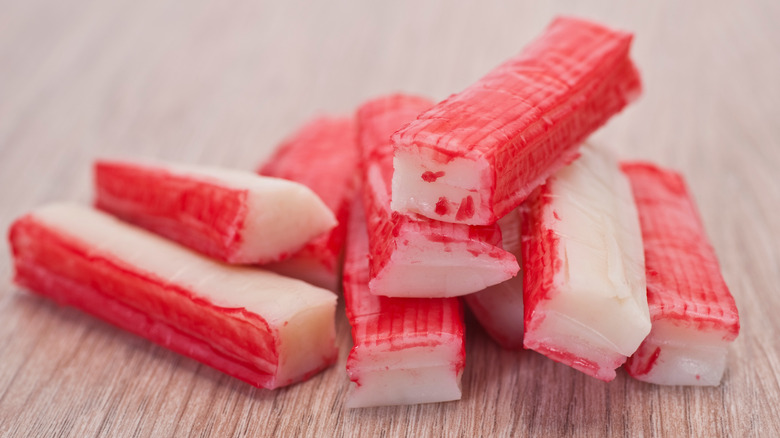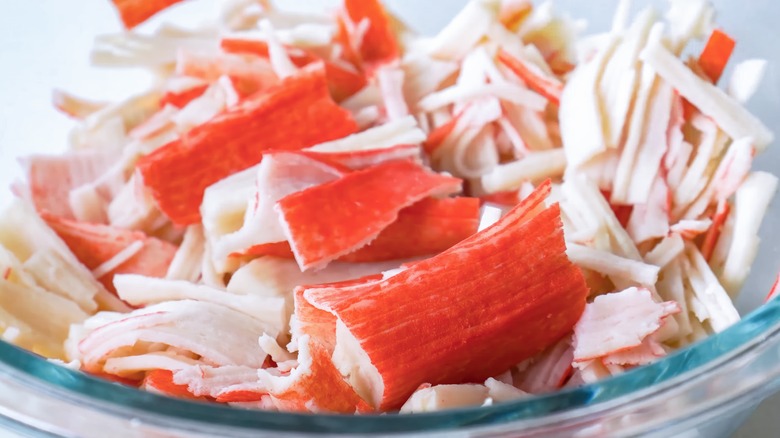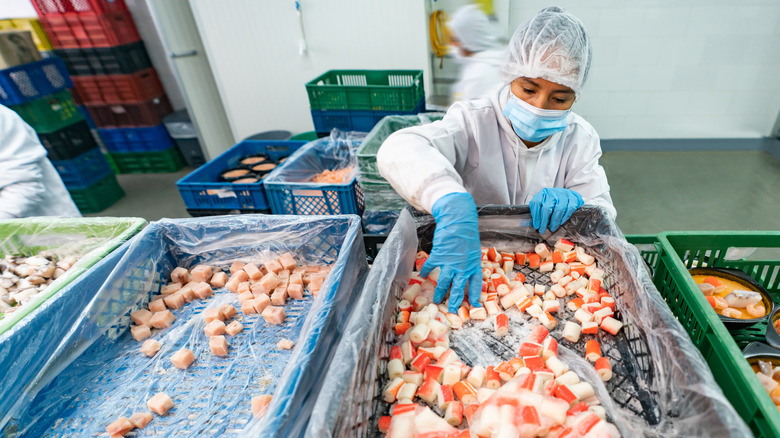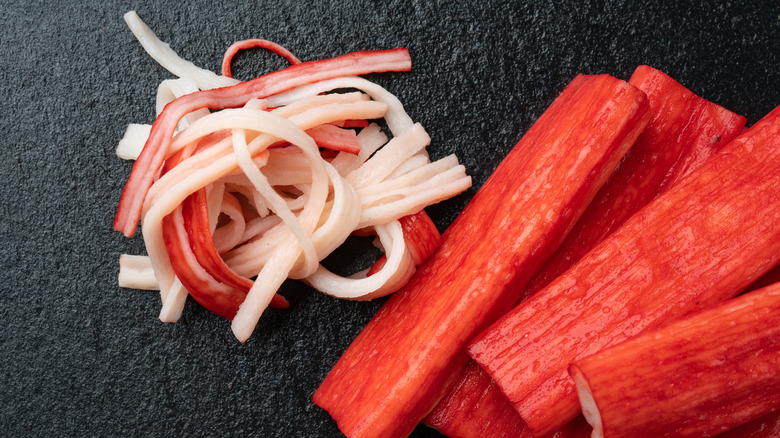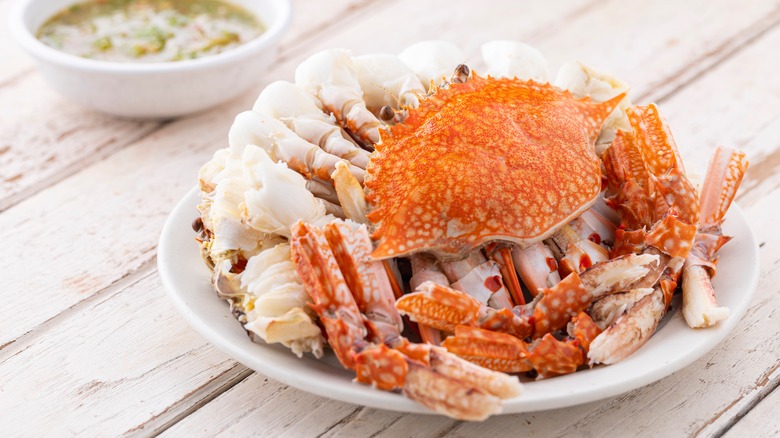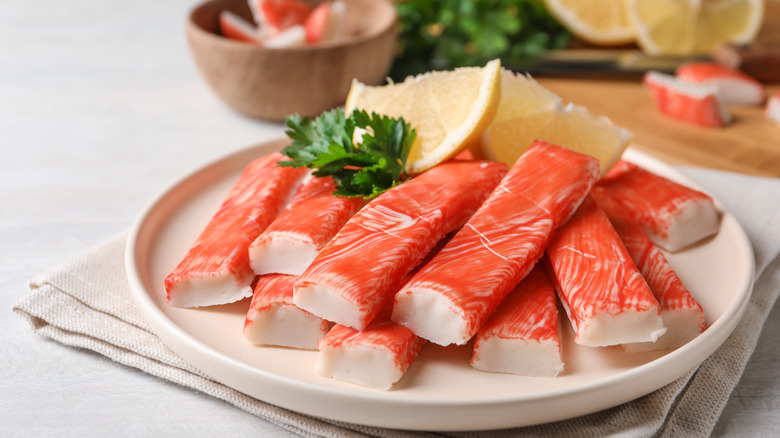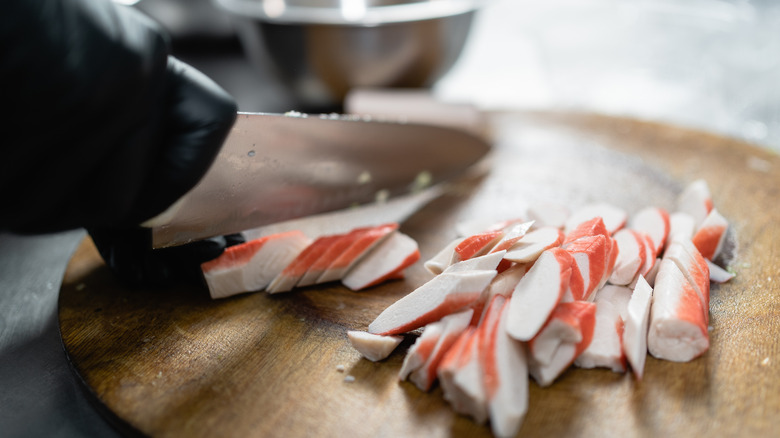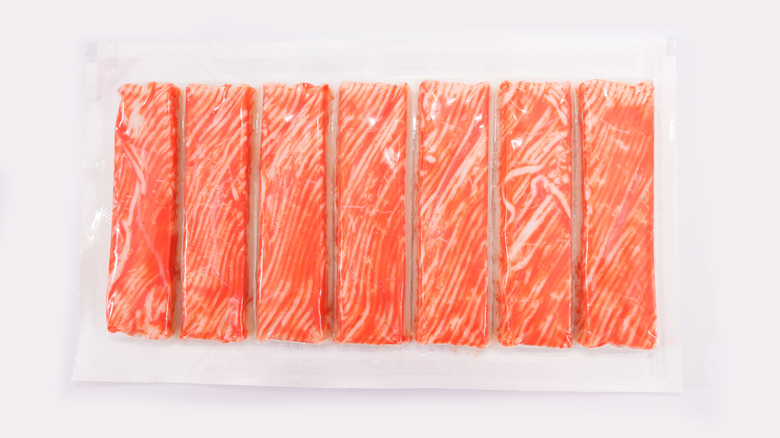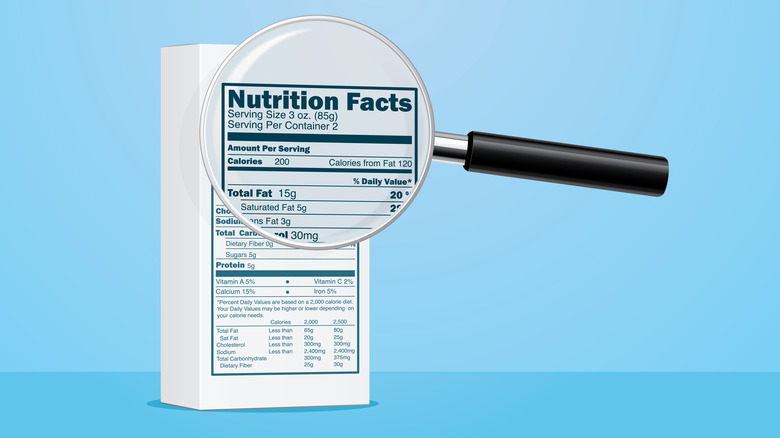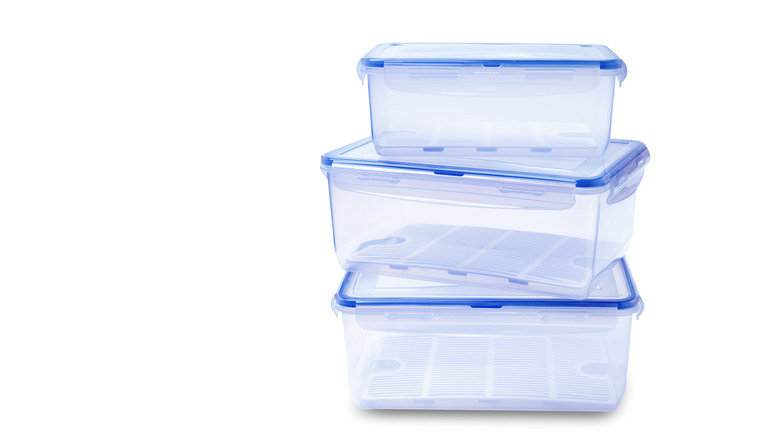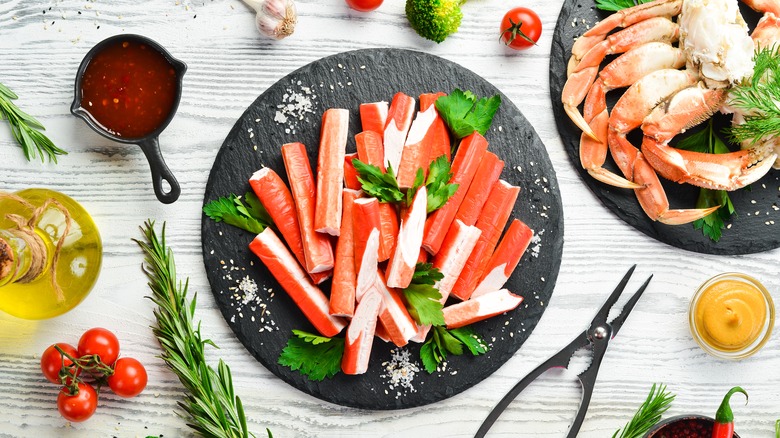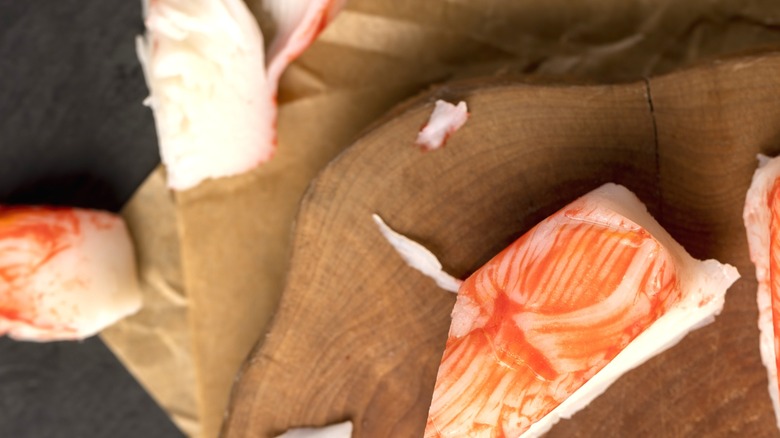What Is Imitation Crab?
There's a good chance you've tried imitation crab, even if you didn't know it at the time. After all, it was designed to look and taste like the real thing. In fact, when it's mixed into dishes like crab cheese wontons it may be hard to tell the difference between it and actual crab meat — but what is it actually made of? Why was imitation crab created, and is it even good for you? The answers to these questions may be somewhat surprising. Whether you're considering cooking with imitation crab or simply want a better understanding of what you are ordering (and consuming), knowing what faux crab really is will help you make the best decisions.
To uncover the mystery behind imitation crab I combed through food blogs, various news sources, nutrition sites, and more. I also recalled growing up on the Chesapeake Bay, where blue crab is basically a major food group (yes, Maryland crab cakes are better!), and my experiences with imitation crab in restaurants. Combined, these sources and experiences provided me with a wealth of information pertaining to the origin, creation, and use of imitation crab. Keep reading to learn what I discovered regarding what faux crab is really made of so the next time you come across a dish with the ingredient or see it at the store you know exactly what you're dealing with.
What is imitation crab?
Imitation crab is also known by the names krab and surimi, but regardless of what you call it, it's all the same thing: A processed form of white fish. Technically, surimi is its own thing (ground, salted fish paste with sugar). However, surimi is the main component of imitation crab, so the terms are frequently used interchangeably.
In addition to the white fish, which is typically Alaskan Pollock or codfish, imitation crab also contains a few other ingredients. The possible ingredients vary from one brand to the next, but common additions include things like sugar, egg whites, cornstarch, water, and sorbitol. Small amounts of actual crab meat, fish oil, soy lecithin, salt, rice wine, tapioca starch, paprika, and more can also be present. Really, there's a whole slew of potential ingredients that can be used to make imitation crab, it just depends on the brand's recipe.
Added preservatives and colorings are also commonly used to make imitation crab. Some products even contain MSG. Colorings are used to give a vibrant red stripe to the white meat so it looks more like the real thing. Once the imitation crab is formed, either into sticks, flakes, or shredded pieces, it has a similar appearance and texture to authentic crab meat.
How is imitation crab made?
Turning white fish into imitation crab is a fairly involved process. Fortunately, you don't have to worry too much about the details because it's perfectly formed when it reaches stores. It's extremely unlikely you would attempt making it yourself either.
Making imitation crab starts with white fish paste (aka surimi). First, the white fish (most likely pollock or codfish) is deboned and cleaned. Then, it is pulverized, minced, or shredded until it becomes a fine paste. At this point, most companies incorporate any additional ingredients used in their recipe, including additives and binding agents, to enhance texture and flavor overall. Next, the fish paste is heated and formed into various shapes, like sticks or something that resembles a crab leg. Finally, the resulting imitation crab is typically painted or dyed with a bold orange or red colored stripe to give it an authentic appearance.
After the imitation crab is molded, all that's left to do is pasteurize and package it. By the time you get your hands on it, you can eat it straight from the bag. We aren't necessarily recommending you consume it that way, but it can be done all the same.
Why was imitation crab created?
Surimi has been around since the 12th century, but imitation crab was first introduced to Japan in the 1970s. It was initially designed to serve as a cost-friendly alternative to real, fresh crab meat, which can often be quite expensive. Even if you opt to buy pre-picked and processed bags of frozen crab meat, it can still come with a higher than expected price tag. So, creating an inexpensive substitution had mass appeal, especially if it could be done correctly. Thankfully, the creators nailed it. Additionally, imitation crab's precooked composition allowed it to be seen as a convenient snack. Both things contributed to its welcome reception, eventual popularity, and inevitable global expansion.
Imitation crab may have gotten its start in Japan, but its rapid success resulted in it spreading all over Asia. After about 10 years it spread even further and became available in the United States. Fast forward to today and it is a commonplace ingredient in restaurants and grocery stores alike. All things considered, we think it's more than fair to say imitation crab was a successful endeavor regarding making a less expensive crab meat alternative without sacrificing flavor or texture.
Imitation crab vs. real crab
The number one difference between imitation crab and real crab is that the faux stuff is actually made from white fish (and a few other ingredients), whereas actual crab is just meat from the crustacean. They both come from the sea, but they aren't even the same animal. The differences don't stop there, either. Sure, they taste, feel, and look a lot alike, but that's where the similarities end. From pricing to nutrition to color, real and imitation crab are quite different.
When it comes to nutrition, real crab blows faux crab out of the water — real crab is way more nutritionally dense than krab. Imitation crab also tends to have a more vibrant red color than authentic meat. The red hue is added to give imitation crab a realistic appearance, but sometimes it is taken a step too far.
When you compare whole fresh crabs to imitation crab you encounter another huge difference. One is ready to eat out of the bag, and the other requires a laborious extraction process to access the meat. If you don't know how to eat blue crab from the shell, trust us, it's quite the task. Finally, krab is much cheaper than actual crab meat. While this isn't a physical difference in the food, it can affect your purchasing habits.
What does imitation crab taste like?
As the name suggests, imitation crab does in fact taste like real crab and it has the same texture, too. It was designed to be that way and the original creators did not disappoint. Just like the real meat, faux crab features a slightly sweet flavor. It also has a touch of saltiness from the sea but remains fairly mild overall. As a result, it is delicious when dipped in butter and seasoned with a world of flavors like Old Bay Seasoning, garlic, lemon, and much more.
According to The Pioneer Woman, "Imitation crab tastes undeniably like seafood and is seasoned with the intent of it mimicking crab." When combined with other flavorful ingredients and seasonings the taste of imitation crab is so accurate that I find it becomes quite challenging to detect a difference. It almost seems unbelievable that fish could be confused for crab, but thanks to expert production, it happens all of the time. Don't believe us? Make a dish with imitation crab and see if anyone notices. You may just be surprised at the lack of detection. I mean, we'd like to think someone with a refined palate, like Gordon Ramsay, would be able to tell the difference, but who knows? Plus, it is highly likely you've been fooled before at a restaurant.
How to cook with imitation crab
Conveniently, imitation crab is cooked when it is processed. As a result, it can be eaten without any further cooking. It can also be incorporated into a world of cuisines that require cooking. Basically, anything that calls for crab can be made with the faux version. It is a fantastic addition to dishes that feature a myriad of other ingredients because it blends in with ease. When mixed properly, it will be difficult to tell whether it is real or fake. Not that you are trying to trick anyone, but the flavor and appearance are more than accurate.
Imitation crab and sushi make the best of friends. It is commonly used in Japanese cuisine anyway, and since it's already cooked, it's super easy to integrate. In addition to classic sushi rolls, like a California roll, krab also goes really well with inspired renditions like mini sushi bake cups. If you want to branch out a bit, I also recommend using the imitation stuff in crab rangoon nachos and creamy dips.
Faux crab is a no-brainer for fresh salads because it's ready to add without additional cooking. It makes a tasty seafood salad with shrimp, imitation crab, and scallops. Or, you can easily prepare a crab Louie salad with it. However you choose to use krab, its vibrant color and eerily similar taste and texture to the real thing ensures it won't go unnoticed.
Where to buy imitation crab
Imitation crab meat is fairly easy to track down at major grocery stores such as Whole Foods, Safeway, and Walmart. It is also readily available in Asian markets and through a myriad of online purveyors. In fact, you may even be able to find more than one brand at your local grocery store (at Asian markets it's pretty much guaranteed).
Imitation crab comes in sticks, flakes, and shredded pieces of varying sizes and can often be found in the frozen, refrigerated, and canned sections of a store. Depending on where you shop, you may only be able to find one version, but that shouldn't be a concern. Most forms of imitation crab are great for incorporating into a world of dishes. Of course, if you plan on using tiny shredded pieces in a recipe it may be best to pick up flakes, but don't let the details prevent you from purchasing a specific kind.
Purchase a 40-ounce bag of imitation crab through Walmart for $9.98.
Purchase a 32-ounce bag of imitation crab through Safeway for $8.49.
Purchase a 3.53-ounce bag of imitation crab through Amazon for 9.99.
Nutritional information of imitation crab: Is it healthy?
Compared to authentic crab meat, imitation crab is nutritionally inferior. Due to the slight variation of ingredients, the nutritional value of imitation crab fluctuates. Even so, it doesn't measure up to the real thing. Actual crab meat has a high protein content and a low carb content, whereas the opposite is true for imitation crab. A serving of imitation crab generally contains about 12.8 grams of carbohydrates and 6.48 grams of protein. Adversely, the same amount of real crab meat is packed with 15.6 grams of protein and zero carbohydrates, notes Medical News Today.
Medical News Today also points out that one area where imitation crab meat comes out on top is sodium. It has less of it than real crab meat. It also boasts a fair amount of phosphorus and selenium. However, it doesn't have as many omega-3 fatty acids (unless they are added by the brand) and various other vitamins and minerals. Many imitation crab products also contain preservatives, colorings, and other additives that could be seen as unhealthy.
All things considered, imitation crab isn't necessarily bad for you. It isn't great for people practicing a low-carb diet and it isn't nearly as nutritionally dense as real crab meat. Still, it's not unhealthy, it just isn't packed with a ton of nutrients. Some brands infuse their imitation crab with extra benefits like omega-3 fatty acids, but this isn't the standard by any means.
How to store imitation crab
The best way to keep imitation crab preserved is to keep it in the unopened packaging it comes in. However, once the original packaging seal is broken, it must be stored in the fridge or freezer. Either way, leftover imitation crab should be kept in an airtight container. There's really not much to it. Treat it like the majority of other foods and you should be able to preserve it for use over the next few days.
When frozen, imitation crab can last for up to nine months. That gives you plenty of time to come up with creative ways to use it. However, if you opt to simply put it in the fridge, eating it within three days is recommended. With small packages, this may not be an issue, but if you have a large amount or aren't quite sure how you will use it just yet, it is probably best to freeze the majority of your unused imitation crab after the initial package is opened.
Should you cook with imitation or real crab?
For most recipes, it doesn't really matter whether you cook with imitation or real crab. Both options get the job done. After all, krab was designed to be a substitute for the real thing and they did a fantastic job actualizing the concept. Even so, there are some things to consider when choosing which product to cook with. First, imitation crab is less expensive. So, if you're looking to save some coin, it's the obvious choice. Krab is also easier to use, at least when you compare it to fresh crab because you don't have to hand-pick the meat from the shell. Of course, if you buy bags of pre-processed crab meat the difference in difficulty insignificant.
Real crab meat makes a better choice if you want to prioritize increased nutritional value in your meal. While imitation crab isn't bad for you, it simply isn't as nutritionally dense as real meat. Krab also contains additives and colorings that could be a turnoff for some people. And you may want to consider using real crab if it is the centerpiece of a meal, like with lump crab cakes.
Lastly, if you're cooking for someone with an egg, soy, or shellfish allergy you'll want to double-check the packaging if you're considering using imitation crab. Many products are not suitable for these allergies because they contain small amounts of egg whites, soy, or even real crab. Of course, they aren't good for plant-based diets, either.
How can you tell if crab meat is imitation or real?
Imitation crab and real crab meat look so alike, sometimes it can be difficult to tell them apart. Obviously, if you're looking at an actual crab, shell and all, you know it's not imitation, but what about the processed bags? They aren't always super specific and in some cases, the word imitation may not be displayed in an obvious manner. Even so, the best way to determine what you are buying or cooking is to examine the packaging. If the words krab or imitation are present, you're not dealing with the real thing.
Another indicator that a particular product is imitation crab is the price. If the cost is suspiciously low for seafood, there's a chance it is imitation. When in doubt, you can always check the ingredients listed on the back. Due to imitation crab's slew of additives, it will immediately be apparent whether or not a particular option is real or imitation. For the most part, real crab will only list crab and maybe one or two other ingredients.
Once the crab meat in question is out of the bag, it becomes trickier to tell whether it is real or faux. Still, the size and shape of the meat can often be a good indicator. If the cuts look super precise, like it's been shaped, it's probably imitation crab.

